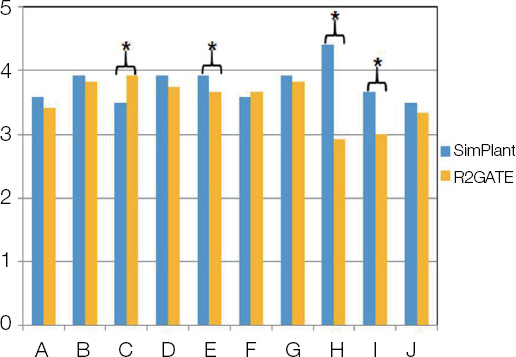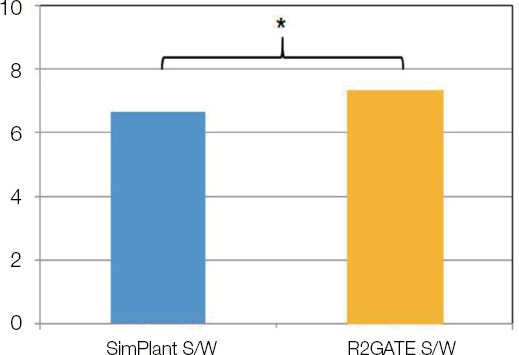J Dent Rehabil Appl Sci.
2015 Sep;31(3):178-185. 10.14368/jdras.2015.31.3.178.
An analysis on satisfaction level of clinicians on implant surgical guidance system based on computed tomography
- Affiliations
-
- 1Department of Prosthodontics, College of Dentistry and Advanced Dental Device Development Institute, Kyungpook National University, Daegu, Republic of Korea. kblee@knu.ac.kr
- KMID: 2180015
- DOI: http://doi.org/10.14368/jdras.2015.31.3.178
Abstract
- PURPOSE
The purpose of this study was to conduct a comparative assessment on the satisfaction level for the two interfaces of surgical guide system (SimPlant and R2GATE), the design and convenience of manufactured surgical guides and the importance of using the surgical guides thereof by means of survey.
MATERIALS AND METHODS
Hereupon, they simulated the implant surgical process by mounting the two manufactured systems of surgical guide on a dental mold, respectively. The study subjects were instructed to complete the questionnaire as to the satisfaction level upon completion of the simulated surgery. This study summarized the data of each question after collecting the completed questionnaires. Then, this study analyzed the summarized data by utilizing statistical program SPSS 20.0 (IBM).
RESULTS
R2GATE had a higher value of the satisfaction level on the design and convenience of manufactures surgical guides. R2GATE group (7.33 +/- 1.26) was found to have a higher value in terms of the overall satisfaction level compared to SimPlant group (6.67 +/- 1.26) (alpha = 0.05).
CONCLUSION
The user satisfaction level on the surgical guide manufactured for R2GATE system was to such an extent as it can be widely used in clinical environment. Moreover, the surgical guide manufactured as R2GATE system can guide both the length and direction of a drill simultaneously. As a result, it is highly recommended for those beginners who do not have a lot of experience in implant placement.
Keyword
MeSH Terms
Figure
Reference
-
References
1. Hounsfield GN. Computerized transverse axial scanning (tomography) 1. Description of system. Br J Radiol. 1973; 46:1016–22. DOI: 10.1259/0007-1285-46-552-1016. PMID: 4757352.2. Schmuth GP, Freisfeld M, Köster O, Schüller H. The application of computerized tomography (CT) in cases of impacted maxillary canines. Eur J Orthod. 1992; 14:296–301. DOI: 10.1093/ejo/14.4.296. PMID: 1516662.3. Schulze D, Heiland M, Thurmann H, Adam G. Radiation exposure during midfacial imaging using 4- and 16-slice computed tomography, cone beam computed tomography systems and conventional radiography. Dentomaxillofac Radiol. 2004; 33:83–6. DOI: 10.1259/dmfr/28403350. PMID: 15313998.4. Becker CM, Kaiser DA. Surgical guide for dental implant placement. J Prosthet Dent. 2000; 83:24851. DOI: 10.1016/S0022-3913(00)80018-9.5. George FM, Chan HL, Razzoog ME, Oh TJ. Fabrication of a cast-based implant surgical guide using guide sleeves. J Prosthet Dent. 2011; 106:409–12. DOI: 10.1016/S0022-3913(11)60156-X.6. Valente F, Schiroli G, Sbrenna A. Accuracy of computer-aided oral implant surgery: a clinical and radiographic study. Int J Oral Maxillofac Implants. 2009; 24:234–42. PMID: 19492638.7. Ruppin J, Popovic A, Strauss M, Spüntrup E, Steiner A, Stoll C. Evaluation of the accuracy of three different computer-aided surgery systems in dental implantology: optical tracking vs. stereolithographic splint systems. Clin Oral Implants Res. 2008; 19:70916. DOI: 10.1111/j.1600-0501.2007.01430.x.8. Park JM, Heo SJ, Park EJ. Comparative study on clearance between drilling and bushing of various implant guide systems. Implantology. 2014; 18:194202.9. Lee DH, Lee KB. The comparative study of user satisfaction on various implant engine system. J Dent Rehabil Appl Sci. 2014; 30:9–15. DOI: 10.14368/jdras.2014.30.1.9.10. Lijphart A II. The comparable-cases strategy in comparative research. Comparative Political Studies. 1975; 8:158–77.
- Full Text Links
- Actions
-
Cited
- CITED
-
- Close
- Share
- Similar articles
-
- Commentary on "Reliability of two different presurgical preparation methods for implant dentistry based on panoramic radiography and cone-beam computed tomography in cadavers"
- An evaluation of the stress effect of different occlusion concepts on hybrid abutment and implant supported monolithic zirconia fixed prosthesis: A finite element analysis
- Accuracy of computer-aided template-guided oral implant placement: a prospective clinical study
- A Survey of Surgeons' Satisfactory Level on Using Zero-Setup Implant Surgical Guide System
- A Survey of Surgeons' Satisfactory Level on Using Zero-Setup Implant Surgical Guide System






